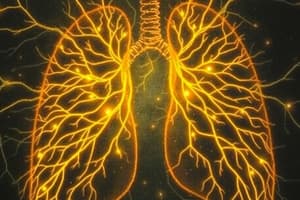Podcast
Questions and Answers
What is the primary stimulus for respiration in clients with emphysema/COPD?
What is the primary stimulus for respiration in clients with emphysema/COPD?
Decreased oxygen concentrations
What is the effect of increasing oxygen concentration on respiratory rate in clients with emphysema/COPD?
What is the effect of increasing oxygen concentration on respiratory rate in clients with emphysema/COPD?
Depresses the respiratory rate
What is the location of the body's respiratory center?
What is the location of the body's respiratory center?
Medulla oblongata and pons of the brain
What is the effect of aging on the chest wall and airways?
What is the effect of aging on the chest wall and airways?
Why is oxygen considered a drug in terms of administration?
Why is oxygen considered a drug in terms of administration?
What is the primary role of the respiratory center in the brainstem during pulmonary ventilation?
What is the primary role of the respiratory center in the brainstem during pulmonary ventilation?
How does lung compliance affect the ease of ventilation?
How does lung compliance affect the ease of ventilation?
What would happen to lung expansion without the presence of surfactant?
What would happen to lung expansion without the presence of surfactant?
What percentage of oxygen is transported to the tissues as oxyhemoglobin?
What percentage of oxygen is transported to the tissues as oxyhemoglobin?
What is the location of the respiratory center that regulates pulmonary ventilation?
What is the location of the respiratory center that regulates pulmonary ventilation?
What is the primary reason for hypoventilation, and how can it be caused by diseases of the respiratory muscles?
What is the primary reason for hypoventilation, and how can it be caused by diseases of the respiratory muscles?
How does hyperventilation increase oxygenation, and what are the methods of achieving it?
How does hyperventilation increase oxygenation, and what are the methods of achieving it?
What is the purpose of pulmonary function tests, and what do they measure?
What is the purpose of pulmonary function tests, and what do they measure?
What is the role of surfactant in the lungs, and how does it relate to lung compliance?
What is the role of surfactant in the lungs, and how does it relate to lung compliance?
What is the location of the respiratory center, and how does it regulate breathing?
What is the location of the respiratory center, and how does it regulate breathing?
What is the primary mechanism by which oxygen is exchanged between the alveoli and the pulmonary capillaries during alveolar-capillary gas exchange?
What is the primary mechanism by which oxygen is exchanged between the alveoli and the pulmonary capillaries during alveolar-capillary gas exchange?
What is the significance of using arterial blood in ABG analysis, and how does it relate to the pulmonary system?
What is the significance of using arterial blood in ABG analysis, and how does it relate to the pulmonary system?
How does lung compliance impact the effort required for ventilation during pulmonary ventilation?
How does lung compliance impact the effort required for ventilation during pulmonary ventilation?
What is the role of surfactant in facilitating lung expansion during inhalation?
What is the role of surfactant in facilitating lung expansion during inhalation?
What is the purpose of applying pressure to the puncture site for at least 5 minutes after an ABG procedure, and why is this necessary?
What is the purpose of applying pressure to the puncture site for at least 5 minutes after an ABG procedure, and why is this necessary?
What is the primary mechanism by which oxygen is transported from the lungs to the tissues?
What is the primary mechanism by which oxygen is transported from the lungs to the tissues?
What is the role of surfactant in pulmonary ventilation, and how would impaired surfactant function affect lung compliance?
What is the role of surfactant in pulmonary ventilation, and how would impaired surfactant function affect lung compliance?
What region of the brainstem is responsible for regulating pulmonary ventilation?
What region of the brainstem is responsible for regulating pulmonary ventilation?
What is the relationship between the heart's electrical activity and the ECG, and how does this relate to oxygen transport in the body?
What is the relationship between the heart's electrical activity and the ECG, and how does this relate to oxygen transport in the body?
What is the significance of assessing adventitious breath sounds, such as crackles, gurgles, and friction rub, in evaluating oxygenation and circulation needs?
What is the significance of assessing adventitious breath sounds, such as crackles, gurgles, and friction rub, in evaluating oxygenation and circulation needs?
What are the early signs of oxygen deprivation, and how do they differ from later signs of severe oxygen deprivation?
What are the early signs of oxygen deprivation, and how do they differ from later signs of severe oxygen deprivation?
How can conditions affecting the heart's pumping action or stroke volume impact cardiovascular function and, in turn, influence respiratory function?
How can conditions affecting the heart's pumping action or stroke volume impact cardiovascular function and, in turn, influence respiratory function?
In left-sided heart failure, how does congestion of the pulmonary vessels impact gas exchange, and what condition may result?
In left-sided heart failure, how does congestion of the pulmonary vessels impact gas exchange, and what condition may result?
What are the clinical signs of hypercarbia (hypercapnia), and how do they relate to respiratory function?
What are the clinical signs of hypercarbia (hypercapnia), and how do they relate to respiratory function?
How can chronic overwork of the heart, such as in clients with uncontrolled hypertension or extensive arteriosclerosis, contribute to heart failure?
How can chronic overwork of the heart, such as in clients with uncontrolled hypertension or extensive arteriosclerosis, contribute to heart failure?
What is the effect of bronchospasm on airways, and how do bronchodilators work to alleviate this?
What is the effect of bronchospasm on airways, and how do bronchodilators work to alleviate this?
How do anti-inflammatory medications promote oxygenation in clients with respiratory disorders?
How do anti-inflammatory medications promote oxygenation in clients with respiratory disorders?
What is the role of expectorants in facilitating oxygenation, and how do they work?
What is the role of expectorants in facilitating oxygenation, and how do they work?
Describe the technique of pursed-lip breathing and its benefits in alleviating dyspnea.
Describe the technique of pursed-lip breathing and its benefits in alleviating dyspnea.
What is the proper technique for using an incentive spirometer, and how does it promote oxygenation?
What is the proper technique for using an incentive spirometer, and how does it promote oxygenation?
How does the location of the respiratory center in the brainstem affect pulmonary ventilation?
How does the location of the respiratory center in the brainstem affect pulmonary ventilation?
What is the role of surfactant in lung compliance, and how does it affect ventilation?
What is the role of surfactant in lung compliance, and how does it affect ventilation?
How does oxygen transport occur in the body, and what is the role of oxyhemoglobin?
How does oxygen transport occur in the body, and what is the role of oxyhemoglobin?
What is the effect of increased oxygen concentration on respiratory rate in clients with emphysema/COPD?
What is the effect of increased oxygen concentration on respiratory rate in clients with emphysema/COPD?
How does lung compliance affect the ease of ventilation, and what are the implications for clients with respiratory disorders?
How does lung compliance affect the ease of ventilation, and what are the implications for clients with respiratory disorders?




